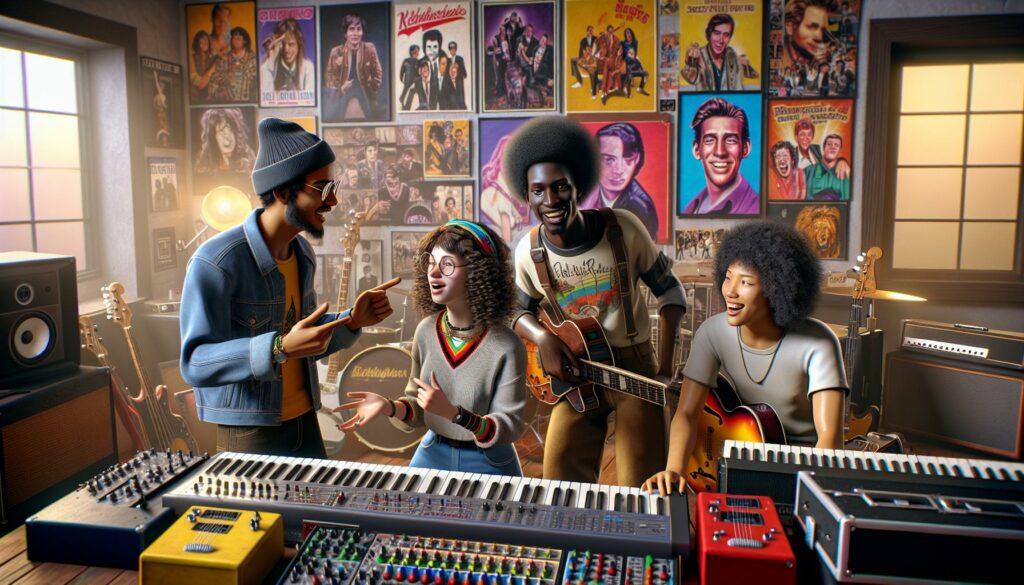Pop music has evolved dramatically since its inception in the 1950s and I’ve watched it splinter into countless exciting subgenres. As a music enthusiast who’s spent years exploring these sonic territories I’m fascinated by how pop continues to reshape itself through various cultural influences and technological advances. When you dive into pop’s subgenres you’ll discover a rich tapestry of sounds from the glossy production of synth-pop to the infectious beats of dance-pop and the raw emotion of power pop. I’ll guide you through the most influential pop subgenres that have shaped today’s musical landscape and help you understand what makes each one unique. Whether you’re a casual listener or a devoted music fan understanding these distinctions will deepen your appreciation for the genre’s diversity.
- Pop music has evolved through distinct eras since the 1950s, branching into multiple subgenres influenced by technology, culture, and artistic innovation. With advancements in digital production, producers now have access to an array of tools, including some of the free sample packs, to create fresh and unique sounds that shape today’s pop music landscape.
- Major pop subgenres include synth-pop, dance-pop, power pop, and newer forms like hyperpop and bedroom pop, each with unique sonic characteristics and production styles.
- The 1980s marked a significant transformation in pop music with the introduction of electronic elements and synthesizers, leading to the creation of synth-pop and new wave.
- Global fusion genres like K-pop and Latin pop have emerged as influential forces, blending regional musical traditions with modern pop production techniques.
- Contemporary pop music continues to evolve through digital innovation, with bedroom pop representing DIY production approaches and hyperpop pushing traditional boundaries with experimental elements.
- Each subgenre maintains distinct characteristics in terms of tempo (BPM), production style, instrumental choices, and vocal approaches, while still adhering to pop music’s core elements of catchy melodies and accessible structures.
Subgenres of POP
1950s-1960s: The Foundation
Pop music emerged from rock and roll roots in the 1950s, establishing core elements like catchy melodies and simple song structures. The British Invasion of the 1960s introduced new sonic textures, with bands like The Beatles blending pop with rock, folk and psychedelic elements.
1970s: Genre Diversification
The 1970s marked pop’s first major split into distinct subgenres:
- Bubblegum Pop: Sweet, Osmonds, Bay City Rollers
- Glam Pop: David Bowie, T. Rex, Roxy Music
- Soft Rock: Carpenters, Bread, America
1980s: Electronic Revolution
Synthesizer technology transformed pop music in the 1980s, creating new subgenres:
| Subgenre | Key Elements | Notable Artists |
|---|---|---|
| Synth-pop | Electronic instruments, programmed beats | Depeche Mode, Pet Shop Boys |
| New Wave | Post-punk influences, angular melodies | Duran Duran, The Cars |
| Dance-pop | Club-oriented rhythms, electronic production | Madonna, Janet Jackson |
1990s: Pop Hybridization
The 1990s introduced cross-genre experimentation:
- Teen Pop: Backstreet Boys, NSYNC, Britney Spears
- Alternative Pop: Alanis Morissette, No Doubt, Garbage
- Latin Pop: Ricky Martin, Jennifer Lopez, Enrique Iglesias
2000s: Digital Innovation
Digital production tools sparked new pop variations:
- Electropop: Lady Gaga, Kesha, La Roux
- Indie Pop: MGMT, Phoenix, Passion Pit
- R&B Pop: Justin Timberlake, Rihanna, Usher
2010s-Present: Genre Fusion
Contemporary pop embraces multiple influences:
- Trap Pop: The Weeknd, Post Malone, Doja Cat
- K-pop: BTS, BLACKPINK, TWICE
- Alt-Pop: Billie Eilish, Lorde, Lana Del Rey
Each era’s technological advancements, cultural shifts and artistic innovations have shaped these subgenres, creating a rich tapestry of pop music styles.
Mainstream Pop and Its Characteristics
Mainstream pop represents the most commercially successful and widely distributed form of pop music. I’ve identified distinct elements that characterize two prominent subgenres within mainstream pop, each with unique sonic signatures and production approaches.
Power Pop
Power Pop combines electric guitar-driven melodies with tight vocal harmonies and infectious hooks. This subgenre emerged in the 1970s with bands like Big Star and The Raspberries, featuring:
- Distorted guitar chords mixed with bright, clean lead lines
- Three-minute song structures centered on verse-chorus formats
- Multi-layered vocal harmonies inspired by 1960s British Invasion groups
- Strong melodic basslines that complement guitar riffs
- Uptempo rhythms with prominent drum patterns
- Four-on-the-floor beats at 118-130 BPM
- Synthesized bass drops and electronic instrumentation
- Hook-laden choruses designed for club environments
- Processed vocals with reverb and delay effects
- Build-ups and breakdowns common in electronic music
| Element | Power Pop | Dance Pop |
|---|---|---|
| Typical BPM | 140-160 | 118-130 |
| Primary Instruments | Electric guitars, drums | Synthesizers, drum machines |
| Production Style | Raw, organic | Polished, electronic |
| Song Length | 2-3 minutes | 3-4 minutes |
| Vocal Approach | Harmonized, natural | Processed, effects-heavy |
Alternative and Indie Pop
Alternative and indie pop emerged in the 1980s as a reaction to mainstream pop’s commercialization, emphasizing DIY ethics, experimental sounds and authentic expression. These subgenres blend pop’s melodic sensibilities with alternative rock’s unconventional approach.
Dream Pop
Dream pop creates atmospheric soundscapes through reverb-heavy guitars, synthesizers and ethereal vocals. The genre features:
- Layered instrumental textures with heavy use of effects pedals
- Breathy, whispered vocals that blend with the instrumentation
- Mid-tempo rhythms typically ranging from 90-120 BPM
- Extended song structures averaging 4-6 minutes
- Notable artists include Cocteau Twins, Beach House and Mazzy Star
Sound characteristics include:
| Element | Description |
|---|---|
| Guitar Effects | Heavy reverb, chorus, delay |
| Production | Wall of sound, ambient textures |
| Vocal Style | Ethereal, often unintelligible |
| Song Structure | Extended, flowing arrangements |
Indie Pop Rock
Indie pop rock combines catchy melodies with raw production values and guitar-driven arrangements. Key elements include:
- Jangly guitar riffs with minimal effects processing
- Lo-fi production aesthetics emphasizing organic sounds
- Emotive vocals with distinctive personality
- Song structures following verse-chorus format
- Notable artists include The Smiths, Belle & Sebastian and Camera Obscura
| Element | Description |
|---|---|
| Recording | DIY/analog methods |
| Mixing | Minimal compression, natural dynamics |
| Instruments | Traditional rock band setup |
| Song Length | 3-4 minutes average |
Electronic Pop Variations
Electronic pop revolutionized mainstream music by integrating digital production techniques with traditional pop structures. Here’s a detailed look at its prominent subgenres.
Synth Pop
Synth pop centers on the synthetic textures of keyboards, drum machines & sequencers. The genre emerged in the 1980s with a defining sound characterized by:
- Analog synthesizers creating lead melodies & bass lines
- Programmed drum patterns at 115-130 BPM
- Minimalist song arrangements with verse-chorus structure
- Digital effects processing on vocals
Notable artists who shaped synth pop include:
| Artist | Key Track | Year | Innovation |
|---|---|---|---|
| Depeche Mode | Just Can’t Get Enough | 1981 | Sequential bass patterns |
| Pet Shop Boys | West End Girls | 1984 | Layered synth textures |
| Gary Numan | Cars | 1979 | Robotic vocal delivery |
Electropop
Electropop builds on synth pop’s foundation with modern production techniques & digital audio workstations. Key characteristics include:
- Heavy use of software synthesizers & virtual instruments
- Complex rhythmic patterns at 120-140 BPM
- Auto-tuned vocal effects & pitch manipulation
- Four-on-the-floor beat structure
| Element | Function | Example Usage |
|---|---|---|
| Side-chain compression | Creates pumping effect | Lady Gaga “”Just Dance”” |
| VST synthesizers | Generates modern textures | La Roux “”Bulletproof”” |
| Digital vocal processing | Adds artificial harmonies | Charli XCX “”1999″” |
Global Pop Fusion
Global pop fusion represents the integration of regional musical traditions with contemporary pop production techniques creating distinctive cultural hybrids. These fusion genres blend local instruments sounds rhythms with modern pop structures.
K-Pop
K-pop emerged from South Korea in the 1990s combining Western pop elements with Korean cultural aesthetics. The genre features:
- Intricate dance choreography synchronized with 8-12 member groups
- Multi-language lyrics mixing Korean English Japanese Chinese
- High-production music videos with specific color palettes costumes
- Complex song structures with multiple hooks rap sections bridges
- Training system producing polished performers through 3-7 year programs
Notable K-pop elements:
| Element | Description |
|---|---|
| Tempo | 120-140 BPM |
| Production | Layered electronic instruments traditional Korean sounds |
| Song Length | 3:00-4:30 minutes |
| Vocal Style | Group harmonies individual parts rap sections |
Latin Pop
Latin pop fuses Spanish-language vocals with contemporary pop production incorporating regional rhythms instruments. Key characteristics include:
- Reggaeton-influenced beats at 90-100 BPM
- Traditional instruments (congas timbales) mixed with electronic elements
- Romantic Spanish lyrics with occasional English phrases
- Emphasis on dance-friendly rhythms salsa bachata influences
- Collaboration between Latin American Caribbean Spanish artists
| Component | Features |
|---|---|
| Rhythm | Dembow patterns tropical percussion |
| Instruments | Digital beats acoustic guitars Latin percussion |
| Structure | Verse-chorus with extended dance breaks |
| Language | Primarily Spanish with bilingual versions |
Modern Pop Subgenres
The contemporary pop landscape features emerging subgenres that push traditional boundaries through digital innovation and DIY production approaches. These newer forms represent the cutting edge of pop music evolution in the streaming era.
Hyperpop
Hyperpop emerged in the late 2010s as an experimental fusion of pop music with exaggerated electronic elements. The genre features distorted bass, pitch-shifted vocals, glitch effects and maximalist production techniques. Key characteristics include:
- Intense sonic compression creating a wall of sound
- Auto-tuned vocals pushed to extreme ranges
- Metallic synthesizer textures layered with trap beats
- Song structures that blend pop hooks with avant-garde elements
- BPM ranges from 140-200
Notable artists creating hyperpop include 100 gecs, Sophie, and Charli XCX’s experimental works.
Bedroom Pop
Bedroom pop represents a lo-fi approach to pop production enabled by accessible recording technology. The genre emerged from independent artists creating music in home studios with minimal equipment. Defining elements include:
- Intimate vocal recordings with natural imperfections
- Simple arrangements using basic MIDI instruments
- Lo-fi production aesthetics with tape-like warmth
- Dreamy synthesizer pads mixed with acoustic instruments
- Average tempos between 80-120 BPM
Artists like Clairo, girl in red and Beabadoobee exemplify the bedroom pop sound through their DIY production approach and authentic songwriting style.
| Subgenre | Average BPM | Key Production Elements | Common Instruments |
|---|---|---|---|
| Hyperpop | 140-200 | Heavy compression, distortion | Digital synths, Auto-tune |
| Bedroom Pop | 80-120 | Lo-fi aesthetics, minimal processing | Basic MIDI, acoustic guitar |
Pop music’s journey through the decades has given birth to an incredible variety of subgenres that continue to shape our musical landscape. I’ve explored how each subgenre brings its unique flavor while maintaining pop’s core essence of accessibility and catchiness.
From synth-pop’s electronic innovation to the global phenomenon of K-pop these subgenres demonstrate pop music’s remarkable ability to evolve and adapt. What excites me most is seeing how new technology and cultural shifts keep creating fresh interpretations of the pop formula.
I believe understanding these subgenres helps us appreciate the artistry behind pop music’s evolution and its lasting impact on global culture. As we move forward I’m eager to see what new subgenres will emerge from this ever-changing musical landscape.



